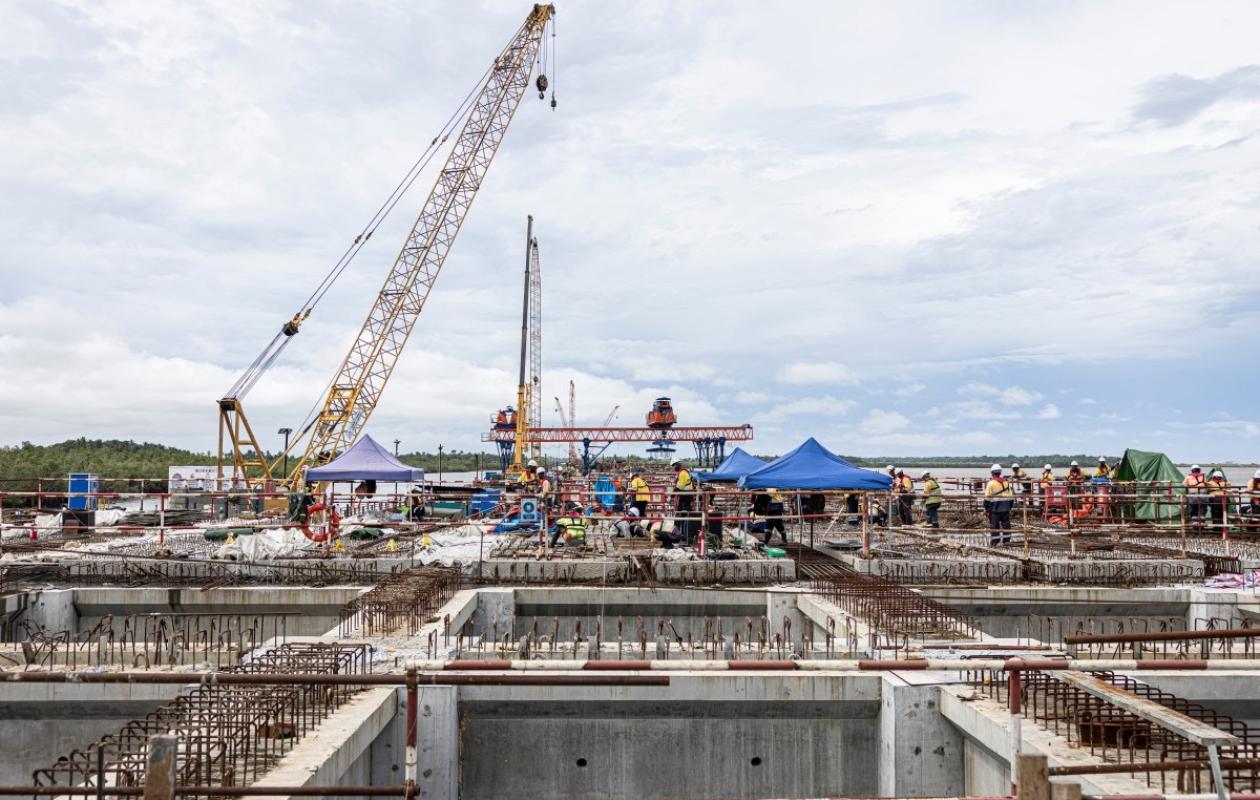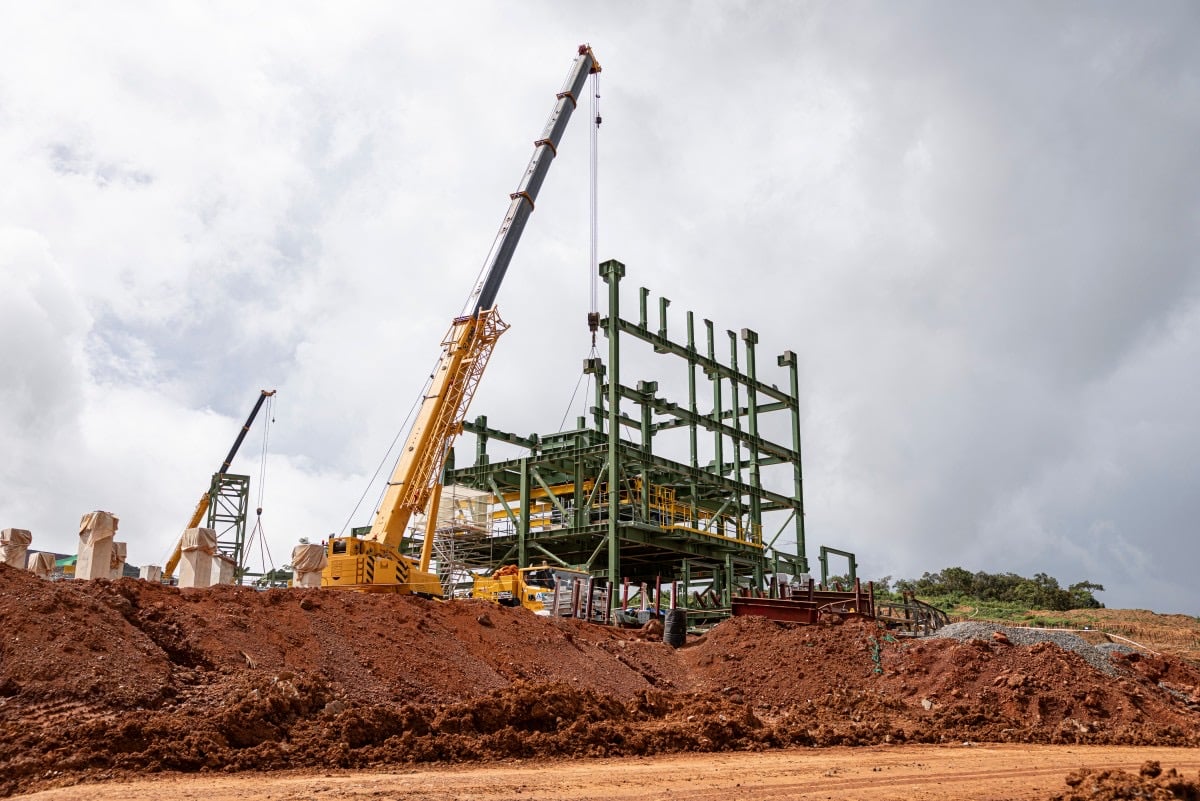
A Simandou, la Guinée s'apprête à exploiter son trésor de fer
At the foot of the Simandou Range, in the lush plains of the Guinean forest, thousands of trucks, workers and excavators have begun to devour the mountain and its blanket of tropical greenery.
A gigantic mining project promises to propel this poor West African country to the ranks of the world's largest iron exporters, raising hopes of boosting the country's economy but also raising concerns among local populations about the project's environmental and social impact.
In a few weeks, Guinea will export its first shipments of iron ore, officially launching production, several decades after the discovery of these deposits in the southeast of the country.
"Not so long ago, this was all virgin forest," said Chris Aitchison, managing director of SimFer, one of the site's operators, hailing the accomplishment of a "monumental task" at all levels.
To open up this region, located hundreds of kilometers from the Atlantic coast, it took 18.5 billion euros of investment from industrial partners, the construction of more than 650 kilometers of railways and a port.
A considerable logistical challenge commensurate with the expected gains from these deposits containing several billion tonnes of rare quality ore.
The price of iron ore, which is used to make steel, has exploded since the early 2000s, boosted by China's construction fever.
Since the Anglo-Australian mining giant Rio Tinto confirmed the deposits in the mid-1990s, Simandou's history has been marked by legal battles, political waltzes and corruption scandals.
The junta of General Mamadi Doumbouya, who came to power in a coup d'état in 2021, boasts of having given the final push to make the project finally become a reality.
Of the four Simandou mining deposits, two will be exploited by the Sino-Singaporean consortium Winning Consortium Simandou (WCS) and the other two by SimFer, a consortium owned by Rio Tinto and the Chinese giant Chinalco.
An AFP team gained access to the SimFer mine, at the southern end of the Simandou mountain range, a few weeks before the start of production scheduled for November 11.
On the slopes of Mount Ouéléba, which rises to an altitude of 1,300 metres, excavators have begun to devour the mountain and piles of black ore are already ready to be exported.
Thousands of people work day and night on the gigantic 55-kilometer-long mine site.
It will take another two and a half years of work to complete the infrastructure and achieve the annual production rate target of 60 million tonnes extracted from the site.
A gigantic conveyor under construction will transport the ore to the foot of the mountain, where it will be loaded onto trains that will reach the coast.
Simfer assures that it is doing everything to limit its environmental impacts and those on local populations, in accordance with international standards.
She emphasizes that she will train 225 students from the region on site over the next three years in skilled technical professions, that a seed bank is collecting samples of local flora to restore it, and that she is gradually rehabilitating the exploited land.
Simfer also says it has spent several hundred million dollars moving its operations to the eastern flank of the mountain in an effort to preserve a population of chimpanzees living near the mine.
However, a report by the Advocates for Community Alternatives (ACA) organization has demonstrated, with supporting analyses, that soil and waterways have been polluted near the SimFer and Winning mines, the port, and along the railway.

The main source of pollution is runoff into waterways surrounding the land exposed by the construction site. "It's a big problem for us," admits Chris Aitchison of SimFer. "We build systems to contain the sediment," he emphasizes.
After a 36-hour train ride from Simandou, the ore will be exported via the Morébaya port complex. Located at the mouth of a river, the two terminals of SimFer and Winning will export 120 million tonnes of ore per year when production is at its peak.
The mountainous landscape has given way to the palm trees of the estuary and the brand new buildings of the SimFer port terminal: thousands of workers are busy on the site, whose construction is due for completion in September 2026.
A few kilometers from the bustle of the port, the village of Touguiyiré, in the prefecture of Forécariah, offers a completely different spectacle, far from the promises of economic prosperity.
On the banks of the calm waters of the river, a canoe returns from fishing. The catch is meager. A few women sort the small fish at the landing stage while the men mend the nets.
Since the arrival of dredging vessels working to connect the port to the offshore export terminals, the fish have disappeared, and with them an entire way of life.
"Before, the canoes would come back with 10 basins of fish. Now they only come back with two," laments Aissata Cissé, a 54-year-old saleswoman.
Fishermen must now venture out onto the high seas, using canoes that are not always suitable. According to Bissiry Camara, a local representative, three of their number recently died there.
Once upon a time, this small village had about sixty pirogues and its approximately 3,000 inhabitants lived off abundant fishing. Only three boats are still in operation, according to the fishermen.
To compensate for these losses, Winning and Simfer distributed food and equipment for deep-sea fishing, such as motors, to local residents.
But due to a lack of sustainable income, the fishermen no longer have the means to maintain their canoes and they remain stranded on the shore.
"The lives of these fishermen are totally threatened," laments Alkaly Bangoura, a member of a committee monitoring the impacts of the Simandou project in the Forécariah prefecture. He says, disillusioned: "We were hoping for a better future with Simandou, but now it's disillusionment."
However, the authorities promise that the mine will boost the country's economy.
The streets of Conakry are lined with a myriad of billboards extolling the Simandou dream, widely promoted by the junta during the last referendum campaign.
The State, which holds a 15% stake in the railway line, is counting on it to open up entire areas and develop agriculture in very fertile regions.
"A new economy will emerge," promises Guinean Prime Minister Amadou Oury Bah, interviewed by AFP, emphasizing that it "will have to be diversified to allow us to move away from this logic of crude exporting countries."
So far, despite the great wealth of Guinea's subsoil, particularly bauxite, which is used to make aluminum, the population has benefited very little from the spin-offs of the mining industry, and the national economy is struggling to take off.
"There have already been other mining projects that have raised a lot of hope (...) but with very limited results," recalls Oumar Totiya Barry, executive director of the Guinean Observatory of Mines and Metals, an independent organization.
The researcher doubts in particular the potential of the Simandou project to open up areas, stressing that its railway line "passes very far from all the major cities in Guinea."
As for the content of the agreement negotiated between the industrialists and the Guinean state in 2022, it remains opaque, despite the obligation under the Guinean mining code to publish these contracts.
Traditionally, tax breaks are granted to miners in exchange for large sums of money invested. But neither the government, SimFer, nor Winning, contacted by AFP, were willing to comment on this point.
The Prime Minister, however, promised transparency, assuring that once production begins, "there is no reason why things should not be made available to the public."
Commentaires (5)
c'est tres bien...
Le Sénégal doit avoir des avantages et même des entreprises dans ce business. C'est normal vu que les guinéens travaille au Sénégal et y gagne leur vie.
Avec cette mine, la Guinée risque d'accroître son PIB face au Sénégal de diomayemoysonko, ces deux vauriens aujourd'hui à la tête du Sénégal.
Pauvres guinéens, le gendarme français à la tête de leur pays va piller toutes les ressources au profit de son employeur. Le temps joue contre eux les pauvres !
Il ne faut surtout pas que le Senegal s'inspire de ce genre de projet. Vrai catastrophe ecologique et environnementale ! Avec le fer de Kedougou on veut un hub industiel dans cette, former les jeunes, developoer les infrastructures socio-economiques. C'est la meilleure facon de lutter contre l'orpaillage traditionnel qui polue les rivieres et contre les trafics de toutes sortes. L'Afrique doir enfin se reveiller. On nous parle d'expirtation de minerais bruts depuis les independances et les regions minieres abritent les populations les plus pauvres avec un environnement totalement detruit.
Participer à la Discussion